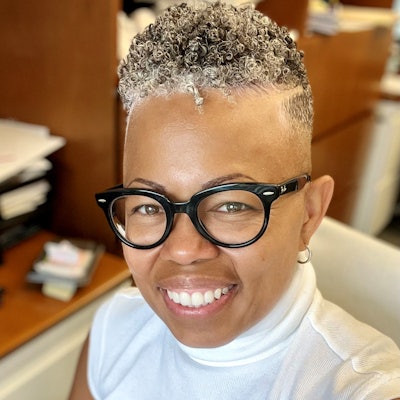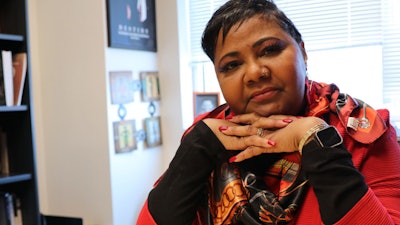There is is a lot of discussion about what K-12 teachers do and don’t (mostly don’t) receive in terms of training in culturally relevant pedagogy, and it is often traced back to teacher education programs. Too often, we hear administrators complaining about their teachers being unprepared/under-prepared to work with Black students. Likewise, we have witnessed frustration by teachers for the same reasons. This inadequate culturally responsive preparation leads to high burnout and turnover rates among White teachers. Consider this:
The World Health Organization’s (WHO) 2019 updated definition of burnout includes three dimensions: “Burnout is a syndrome conceptualized as resulting from chronic workplace stress that has not been successfully managed. It is characterized by three dimensions:
(1) feelings of energy depletion or exhaustion Dr. Kelly A. Rodgers
Dr. Kelly A. Rodgers
(2) increased mental distance from one’s job, or feelings of negativism or cynicism related to one’s job; and
(3) reduced professional efficacy” (WHO, 2019) (see Bouchrika).
Specifically, 44% of teachers in K-12 education reported that they very often or always feel burned out at work. This is one of the 14 occupations in the 2022 Gallup Poll on occupational burnout. Very telling is that female teachers (55%) express more burn out than male teachers (44%). (Marken & Agrawal, 2022).
The statistics are telling and a clarion call for teacher education institutions to evaluate/audit their course offering and syllabi content. We have to really take a step back and think about who's training the teachers with degrees, certification, and licensure -- and that is college faculty. Outside of teacher education, doctoral programs typically do not provide targeted pedagogical training for their graduates. So, if there's no targeted pedagogical education, then there’s little to no exposure to culturally responsive or sustaining pedagogy. These underprepared graduates end up in our college classrooms. At a time when anti-Black sentiment permeates every level of our educational system, the need for educators who are anti-racist, equity-minded, and culturally sustaining is critical, and the stakes, particularly for Black students, are arguably greater in higher education than in K-12.
Black students continue to be overrepresented among those who are the first in their families to seek higher education and, thus, are often the first ones to navigate professional environments like academia and corporate America in their Black bodies. We are their last stop before entering the workplace as professionals. Apart from their parents/caregivers for the first time, these Black young adults are digging out their own space in the world, and the one presented to them must make space for them. Likely, their majority white professors have received very little training to make that space. K-12 administrators can learn to ask better questions during the interview process to assess teachers’ preparation for and commitment to diversity. However, in higher education, many institutions already employ these strategies. Search committees are more likely to directly ask candidates about their commitment to diversity in their application materials and during interviews. In spite of increasing push back against EDI, many campuses offer professional development, typically centering around creating culturally-sustaining course material fostering inclusive classrooms. Dr. Donna Y. Ford
Dr. Donna Y. Ford
Yet, despite this, far too many equity efforts die on the vine. Unlike K-12, higher education has appropriately guarded academic freedom, so close university oversight on equity practices is likely to be met with considerable push back. It is incumbent on faculty, most of whom are white, who say all the right things during interviews to pay more than lip service in doing “the work” to support success among Black college students. While important, “the work” goes deeper than putting Black faces and voices in your curriculum. Here are a few other things faculty can do or ask themselves if they are truly committed to excellence in culturally sustaining pedagogy:
· What parts of their development have your students identified as most central to them? Have you asked? How do your classroom policies center these identities?
· What parts of your students’ identities are most central to you? How do you see that reflected in your course material, policies, and classroom community? Is this fixation in line with how students see themselves?
· What behaviors by students are ‘acceptable' in your classroom? Have you considered that behaviors are often culturally influenced and, thus, not necessarily in need of correction?
· If you are not familiar with Black culture, have you allowed flexibility for students to lead the way, to be culturally different beings who are supported not penalized?
· Will all of your students face the same challenges when they go into the professional world? Will they face the same repercussions? How does your curriculum and policies prepare them for such problems, issues, and injustices?
Our K-12 schools are more diverse than ever before. We urge higher education faculty to, along with their students, get out of the ivory tower and into communities and schools, especially those comprised of Black students. To not do so is a disservice to the profession, their graduates, and K-12 students.
Dr. Kelly A. Rodgers is an Associate Professor of Psychology at the Borough of Manhattan Community College – City University of New York.
Dr. Donna Y. Ford is Distinguished Professor of Education and Human Ecology in the College of Education and Human Ecology at The Ohio State University.















